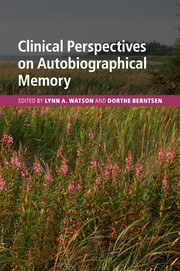Book contents
- Clinical Perspectives on Autobiographical Memory
- Clinical Perspectives on Autobiographical Memory
- Copyright page
- Contents
- Figures
- Tables
- Contributors
- Preface
- Book part
- 1 Introduction
- Part I Trauma and autobiographical memory
- Part II Intrusive and involuntary memories
- Part III Overgeneral autobiographical memories and their mechanisms
- Part IV Autobiographical memory, identity, and psychological well-being
- Part V Discussion
- Index
- References
Part I - Trauma and autobiographical memory
Published online by Cambridge University Press: 05 March 2015
- Clinical Perspectives on Autobiographical Memory
- Clinical Perspectives on Autobiographical Memory
- Copyright page
- Contents
- Figures
- Tables
- Contributors
- Preface
- Book part
- 1 Introduction
- Part I Trauma and autobiographical memory
- Part II Intrusive and involuntary memories
- Part III Overgeneral autobiographical memories and their mechanisms
- Part IV Autobiographical memory, identity, and psychological well-being
- Part V Discussion
- Index
- References
- Type
- Chapter
- Information
- Clinical Perspectives on Autobiographical Memory , pp. 15 - 106Publisher: Cambridge University PressPrint publication year: 2015

